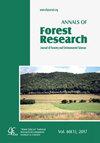A review of Botryosphaeriales in Venezuela with special reference to woody plants
IF 2.9
3区 农林科学
Q2 FORESTRY
引用次数: 0
Abstract
The Botryosphaeriales order is best known for the diseases they cause in woody plants, as primary pathogens or latent pathogens residing in the woody tissue of asymptomatic hosts. In the first instance, Botryosphaeriales species have been identified in Venezuela using morphological descriptions in the ‘80s and ‘90s, and later, the mid-2000s using molecular techniques. The morphological descriptions of the asexual morphs were initially used for the identification of Botryosphaeriales genera and species. Lasiodiplodia spp. (as L. theobromae) was the most isolated fungus in Venezuela within the Botryosphaeriales and has been found in more than 50% of the hosts in native and non-native plants, followed by Diplodia, Dothiorella, Fusicoccum, Microdiplodia, Macrophomina, Neofusicoccum, Sphaeropsis, and Botryosphaeria, considered all of them cosmopolitan group. Molecular studies, that included DNA sequence data from multiple genes, such as the internal transcribed spacer of rDNA (ITS), translation elongation factor-1α (tef1), and β-tubulin (btub) used on the fungi isolated from woody plants, mainly trees or forest species, reveled the presence of two families within the Botryosphaeriales order for Venezuela. Botryosphaeriaceae family includes the genera: Botryosphaeria, Cophinforma, Diplodia, Lasiodiplodia and Neofusicoccum, and the Pseudofusicoccumaceae family includes the genus Pseudofusicoccum. In the Botryosphaeriaceae the Lasiodiplodia genus was the most predominant in most hosts, and the species L. theobromae the most isolated in native and non-native plants. Botryosphaeria dothidea, Cophinforma atrovirens, Diplodia scrobiculata (syn. D. guayanensis), Lasiodiplodia brasiliensis, L. crassispora, L. pseudotheobromae, Neofusicoccum arbuti (syn. N. andinum), N. parvum, and N. ribis are cosmopolitan species, and they were isolated from native and non-native plants. Pseudofusicoccum stromaticum was found in plantations non-native of Acacia mangium, E. urophylla x E. grandis, Eucalyptus urophylla, and reported exclusively in South America. Lasiodiplodia venezuelensis has only been reported in Venezuela, and it was isolated from native and non-native plants. The presence, distribution, diversity, and symptoms of these fungi, mainly of the new genus, new species, and reports found in Venezuela and other parts of the world, were also reviewed.委内瑞拉植物圈属植物综述,特别提及木本植物
Botryosphaeriales目以其在木本植物中引起的疾病而闻名,作为原发病原体或潜伏病原体居住在无症状寄主的木本组织中。首先,在20世纪80年代和90年代,人们利用形态学描述在委内瑞拉发现了Botryosphaeriales物种,后来,在2000年代中期,人们利用分子技术发现了botryosphaiales物种。无性形态的形态描述最初用于植物属和种的鉴定。Lasiodiplodia spp.(如L. theobromae)是委内瑞拉原生和非原生植物中分离最多的真菌,在50%以上的寄主中都有发现,其次是Diplodia、Dothiorella、Fusicoccum、Microdiplodia、Macrophomina、Neofusicoccum、Sphaeropsis和Botryosphaeria,它们都被认为是世界群。分子研究包括来自多个基因的DNA序列数据,例如从木本植物(主要是树木或森林物种)分离的真菌中使用的rDNA内部转录间隔物(ITS),翻译延伸因子-1α (tef1)和β-微管蛋白(btub),揭示了委内瑞拉Botryosphaeriales目中存在两个科。葡萄球藻科包括葡萄球藻属、Cophinforma属、Diplodia属、Lasiodiplodia属和Neofusicoccum属,Pseudofusicoccum科包括Pseudofusicoccum属。在蕨类植物科中,大多数寄主中以Lasiodiplodia属居多,而在本地和非本地植物中分离最多的是L. theobromae。Botryosphaeria dothidea、Cophinforma atrovirens、Diplodia schrobiculata(同d.d . guayanensis)、Lasiodiplodia brasiliensis、l.a assispora、l.a pseudotheobrome、Neofusicoccum arbuti(同n.n andinum)、nparvum和n.r ibis是世界性的物种,它们分别从本地和非本地植物中分离得到。假fusicoccum stromatium是在mangium、尾叶桉、尾叶桉等非本土人工林中发现的,仅在南美洲报道。委内瑞拉Lasiodiplodia Venezuela (Lasiodiplodia Venezuela)仅在委内瑞拉有报道,从本地和非本地植物中分离得到。还审查了这些真菌的存在、分布、多样性和症状,主要是新属、新种,以及在委内瑞拉和世界其他地区发现的报告。
本文章由计算机程序翻译,如有差异,请以英文原文为准。
求助全文
约1分钟内获得全文
求助全文
来源期刊

Annals of Forest Research
FORESTRY-
CiteScore
2.20
自引率
11.10%
发文量
11
审稿时长
12 weeks
期刊介绍:
Annals of Forest Research is a semestrial open access journal, which publishes research articles, research notes and critical review papers, exclusively in English, on topics dealing with forestry and environmental sciences. The journal promotes high scientific level articles, by following international editorial conventions and by applying a peer-review selection process.
 求助内容:
求助内容: 应助结果提醒方式:
应助结果提醒方式:


